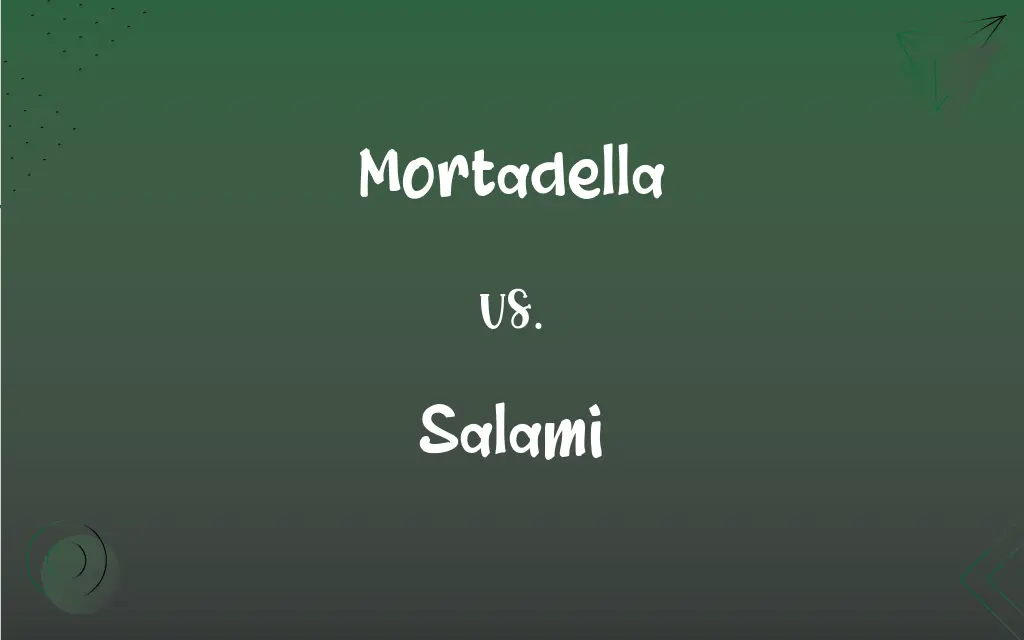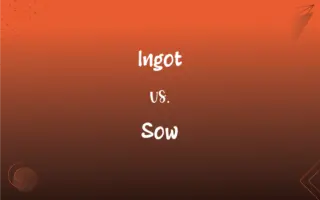Mortadella vs. Salami: What's the Difference?
By Harlon Moss & Janet White || Updated on May 20, 2024
Mortadella is a large Italian sausage made from finely ground, heat-cured pork, often flavored with spices and pistachios. Salami is a cured sausage made from fermented and air-dried meat, usually pork or beef, with a coarser texture and spicier flavor.

Key Differences
Mortadella is a traditional Italian sausage known for its smooth, fine texture and mild flavor. It is made from finely ground pork mixed with spices, and sometimes pistachios or myrtle berries, then heat-cured. Salami, on the other hand, is a type of cured sausage with a coarse texture and more robust, spicy flavor. It is made from fermented and air-dried meat, typically pork or beef, mixed with various spices and herbs.
While mortadella is characterized by its smoothness and mild taste, salami is known for its coarse texture and spicier, more complex flavor profile. Mortadella undergoes heat curing, making it cooked, whereas salami is air-dried and fermented, making it a raw, preserved meat product.
Mortadella's preparation involves finely grinding pork and incorporating chunks of fat, giving it a uniform and smooth appearance. Salami preparation includes a fermentation process, which develops its tangy flavor and firm texture. Mortadella is often sliced very thin due to its delicate texture, while salami can be sliced thin or thick, depending on preference.
In terms of usage, mortadella's mild flavor makes it suitable for light, simple dishes, whereas salami's strong, spicy taste complements more robust flavors and complex dishes. Both are staples in Italian cuisine but offer different eating experiences.
Comparison Chart
Texture
Smooth and fine
Coarse and firm
ADVERTISEMENT
Flavor
Mild, sometimes nutty
Spicy, robust, and tangy
Preparation Method
Heat-cured
Fermented and air-dried
Common Ingredients
Finely ground pork, fat, spices
Coarsely ground pork/beef, spices
Origin
Bologna, Italy
Various regions across Europe
Typical Use
Sandwiches, antipasto, standalone
Charcuterie, sandwiches, pizza topping
ADVERTISEMENT
Appearance
Pink with white fat cubes
Dark red with specks of fat
Serving Style
Usually thinly sliced
Can be thinly or thickly sliced
Mortadella and Salami Definitions
Mortadella
A heat-cured sausage often containing spices and pistachios.
The charcuterie board featured slices of mortadella with pistachios.
Salami
A sausage commonly made from pork or beef mixed with spices.
The chef prepared a salad topped with chunks of salami.
Mortadella
A large, smooth-textured Italian sausage made from finely ground pork.
She enjoyed a mortadella sandwich with fresh ciabatta bread.
Salami
A type of cured sausage made from fermented and air-dried meat.
The platter included several varieties of Italian salami.
Mortadella
A sausage characterized by its pink color and white fat cubes.
The deli displayed a large roll of mortadella behind the counter.
Salami
A preserved meat product from various European regions.
French saucisson sec is a popular type of salami.
Mortadella
A delicacy often served thinly sliced.
He wrapped the mortadella slices around breadsticks for a quick snack.
Salami
A coarse-textured sausage with a robust, spicy flavor.
She added slices of spicy salami to her homemade pizza.
Mortadella
A mild-flavored sausage from Bologna, Italy.
Mortadella is a popular choice for light Italian sandwiches.
Salami
A sausage often featured in charcuterie boards.
The charcuterie included Genoa salami alongside cheeses and olives.
Mortadella
A heat-cured Italian sausage usually made of ground pork and cubes of pork fat and flavored with wine and spices.
Salami
Any of various highly spiced and salted sausages, made from beef or a mixture of pork and beef.
Mortadella
A smooth-textured Italian pork sausage with lumps of fat, flavoured with spices; eaten cold.
Salami
A large cured meat sausage of Italian origin, served in slices.
Salami
(baseball) A grand slam.
Salami
Highly seasoned fatty sausage of pork and beef usually dried
FAQs
What is the texture of mortadella?
Mortadella has a smooth, fine texture.
What is mortadella?
Mortadella is a large, heat-cured Italian sausage made from finely ground pork, often flavored with spices and pistachios.
What is the texture of salami?
Salami has a coarse, firm texture.
Where does mortadella originate?
Mortadella originates from Bologna, Italy.
Can mortadella contain nuts?
Yes, mortadella can contain pistachios or myrtle berries.
Does salami always contain pork?
Salami is often made from pork but can also be made from beef or other meats.
What is salami?
Salami is a cured sausage made from fermented and air-dried meat, usually pork or beef, known for its coarse texture and spicy flavor.
How is salami made?
Salami is made by coarsely grinding meat, mixing it with spices, fermenting it, and then air-drying it.
How is mortadella typically served?
Mortadella is typically served thinly sliced, often in sandwiches or antipasto platters.
Where does salami originate?
Salami originates from various regions across Europe, including Italy, France, and Spain.
How is mortadella made?
Mortadella is made by finely grinding pork, mixing it with spices and fat, and then heat-curing it.
What dishes use mortadella?
Mortadella is used in sandwiches, antipasto platters, and as a snack.
Is mortadella spicy?
Mortadella is generally mild in flavor.
Is salami spicy?
Salami can be spicy, depending on the variety and spices used.
What color is salami?
Salami is typically dark red with specks of fat.
Is mortadella cooked?
Yes, mortadella is heat-cured, making it a cooked sausage.
What dishes use salami?
Salami is used in charcuterie boards, sandwiches, salads, and as a pizza topping.
How is salami typically served?
Salami is served in slices, either thin or thick, on charcuterie boards, in sandwiches, or as a pizza topping.
What color is mortadella?
Mortadella is pink with white fat cubes.
Is salami cooked?
No, salami is cured through fermentation and air-drying, not cooking.
About Author
Written by
Harlon MossHarlon is a seasoned quality moderator and accomplished content writer for Difference Wiki. An alumnus of the prestigious University of California, he earned his degree in Computer Science. Leveraging his academic background, Harlon brings a meticulous and informed perspective to his work, ensuring content accuracy and excellence.
Co-written by
Janet WhiteJanet White has been an esteemed writer and blogger for Difference Wiki. Holding a Master's degree in Science and Medical Journalism from the prestigious Boston University, she has consistently demonstrated her expertise and passion for her field. When she's not immersed in her work, Janet relishes her time exercising, delving into a good book, and cherishing moments with friends and family.
































































